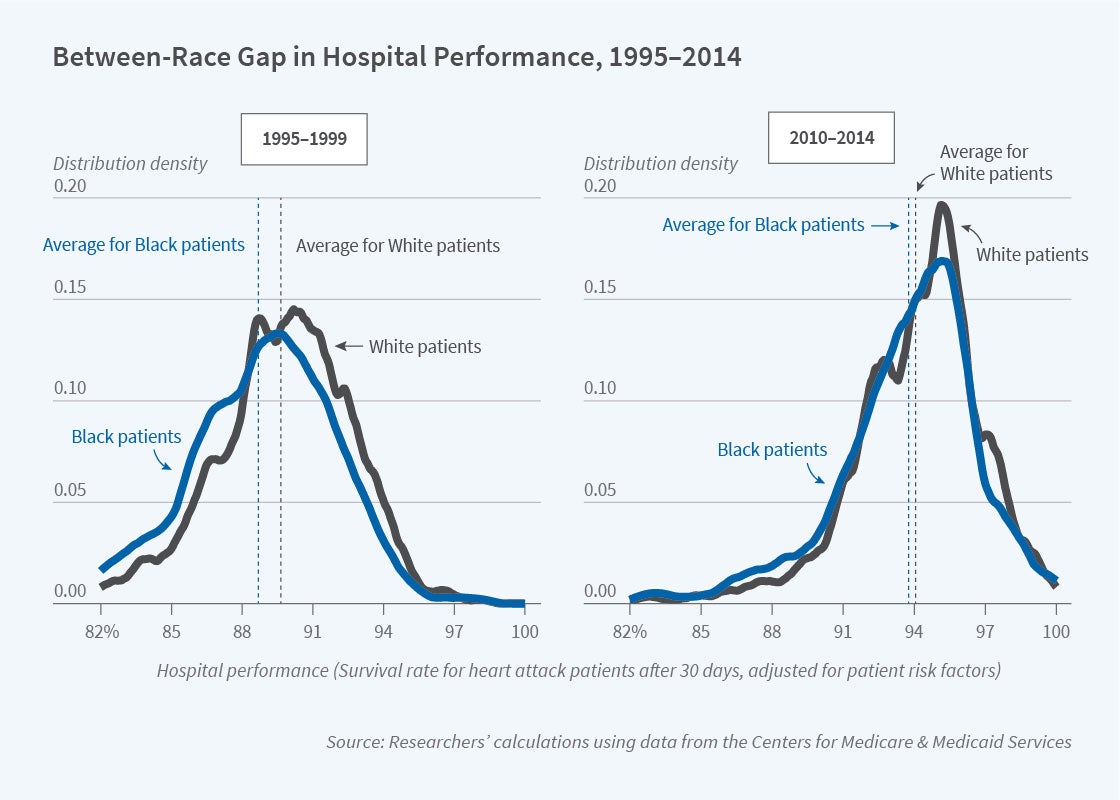How Hospital Choice Contributes to Racial Disparities in Heart Attack Treatment
Black Americans experience 20 percent higher mortality rates, after adjusting for age, than White Americans. One potential contributor to this disparity is the tendency for Black and White patients to receive treatment from health care providers with differing levels of performance.
Among heart attack patients in the late 1990s, for example, Black patients were treated in hospitals where the typical patient had a 1 percentage point lower survival rate after 30 days than hospitals where White patients were treated. The left panel of the figure compares the distribution of survival rates at hospitals used by Black and White patients in the late 1990s. It shows that Black patients were treated at hospitals with lower survival rates than their White counterparts. The right panel shows, however, that this gap narrowed substantially over time. By the early 2010s, Black heart attack patients were using hospitals with 0.3 percentage point lower survival rates.
In Hospital Allocation and Racial Disparities in Health Care (NBER Working Paper 28018), researchers Amitabh Chandra, Pragya Kakani, and Adam Sacarny examine the sources of these disparities and their changes over time. To do so, they analyze hospitalization records for Black and White Medicare beneficiaries experiencing a heart attack between 1995 and 2014.
Some differences in hospital performance arise due to where Black and White patients live, affecting their access to high-performing hospitals. In fact, 44 percent of the Black-White disparity in the late 1990s was attributable to differences in the hospital markets where the patients lived. Another 25 percent of the disparity reflected the fact that Black patients lived in different neighborhoods (proxied by ZIP codes) within these hospital markets. The remaining gap was due to differences in hospital choices among patients who lived within the same neighborhood. The research does not address racial disparities in health outcomes within a hospital, focusing exclusively on differences arising from choice of hospital.
By the early 2010s, the Black-White gap had narrowed and differences between hospital markets where Black and White patients lived no longer significantly contributed to it. Instead, differences in hospital choice within hospital markets played a larger role. Forty-five percent of the remaining Black-White gap was attributable to differences across neighborhoods within hospital markets, with the remaining 54 percent related to differences in hospital choice within a neighborhood.
The researchers next seek to explain the reason that the Black-White gap in hospital performance shrank so much over this time period. That change could have occurred due to stronger performance improvement at hospitals that tended to serve Black patients, or it could have been the result of Black patients shifting to higher-performance hospitals more quickly than White patients. They find evidence that the former channel — performance rising at hospitals serving Black patients — fully explains the disparity reduction over time.
To better understand the differential improvement in treating heart attacks at hospitals that tend to treat Black patients, the researchers explore differences across hospitals in the diffusion of new technologies. They conclude that the adoption of low-cost technologies — such as beta-blockers — may have contributed to the differential performance improvements. Hospitals that tended to serve Black patients adopted such technologies more quickly. They show that these patterns were reversed for capital-intensive technologies like cardiac catheterization, suggesting that diffusion of high-cost technologies does not explain narrowing racial disparities in hospital performance.
The researchers conclude that efforts to improve performance at hospitals that serve marginalized racial and ethnic groups can substantially reduce inequities in health outcomes. While changes in hospital choice played a more limited role in reducing disparities in heart attack outcomes in the study, it may be feasible to harness referral patterns and provider networks to reduce disparities in the future. Their work also highlights the potential for technology diffusion as a disparity-reducing (or increasing) force.
The researchers acknowledge support from the National Institute on Aging grants P01-AG005842 (all researchers) and T32-AG000186 (Kakani) and from the Agency for Healthcare Research and Quality grant T32-HS000055 (Kakani).



